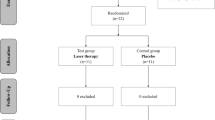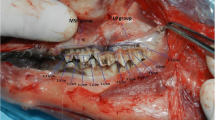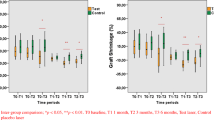Abstract
The erbium-doped yttrium aluminum garnet (Er:YAG) laser is currently used for periodontal soft tissue management with favorable outcomes. However, the process of wound healing after Er:YAG laser (ErL) treatment has not been fully elucidated yet. The aim of this study was to investigate the gingival tissue healing after ErL ablation in comparison with that after electrosurgery (ElS). Gingival defects were created in 28 rats by ablation with ErL irradiation or ElS. The chronological changes in wound healing were evaluated using histological, histometrical, and immunohistochemical analyses. The ErL-ablated gingival tissue revealed much less thermal damage, compared to the ElS. In the ElS sites, the postoperative tissue destruction continued due to thermal damage, while in the ErL sites, tissue degradation was limited and the defects were re-epithelialized early. Heat shock protein (Hsp) 72/73 expression was detected abundantly remote from the wound in the ElS, whereas it was slightly observed in close proximity to the wound in the ErL sites. Hsp47 expression was observed in the entire connective tissue early in the wound healing and was found limited in the wound area later. This phenomenon proceeded faster in the ErL sites than in the ElS sites. Expression of proliferating cell nuclear antigen (PCNA) persisted in the epithelial tissue for a longer period in the ElS than that in the ErL. The ErL results in faster and more favorable gingival wound healing compared to the ElS, suggesting that the ErL is a safe and suitable tool for periodontal soft tissue management.





Similar content being viewed by others
References
Aoki A, Sasaki KM, Watanabe H, Ishikawa I (2004) Lasers in nonsurgical periodontal therapy. Periodontol 2000 36:59–97
Ishikawa I, Aoki A, Takasaki AA (2004) Potential applications of erbium:YAG laser in periodontics. J Periodontal Res 39:275–285
Cobb CM (2006) Lasers in periodontics: a review of the literature. J Periodontol 2000 77:545–564
Ishikawa I, Aoki A, Takasaki AA, Mizutani K, Sasaki KM, Izumi Y (2009) Application of lasers in periodontics: true innovation or myth? Periodontol 50:90–126
Pang PAS, Aoki A, Coluzzi D, Obeidi A, Olivi G, Parker S, Rechmann P, Sulewski J, Sweeney C, Swick M, Yung F (2011) Laser energy in oral soft tissue applications. J Laser Dent 18:123–131
Izumi Y, Aoki A, Yamada Y, Kobayashi H, Iwata T, Akizuki T, Suda T, Nakamura S, Wara-Aswapati N, Ueda M, Ishikawa I (2011) Current and future periodontal tissue engineering. Periodontol 2000 56:166–187
Hale GM, Querry MR (1973) Optical constants of water in the 200-nm to 200-μm wavelength region. Appl Opt 12:555–563
Walsh JT Jr, Flotte TJ, Deutsch TF (1989) Er:YAG laser ablation of tissue: effect of pulse duration and tissue type on thermal damage. Lasers Surg Med 9:314–326
Schwarz F, Sculean A, Georg T, Reich E (2001) Periodontal treatment with an Er: YAG laser compared to scaling and root planing. A controlled clinical study. J Periodontol 72(3):361–367
Gaspirc B, Skaleric U (2007) Clinical evaluation of periodontal surgical treatment with an Er:YAG laser: 5-year results. J Periodontol 78(10):1864–1871
Watanabe H, Ishikawa I, Suzuki M, Hasegawa K (1996) Clinical assessments of the erbium:YAG laser for soft tissue surgery and scaling. J Clin Laser Med Surg 14:67–75
Aoki A, Watanabe H, Namiki N, Takiguchi T, Miyazawa Y, Suzuki M, Hasegawa K, Ishikawa I (2003) Periodontal soft tissue management with a high pulse rate Er:YAG laser. Int Congr Ser 1248:367–369
Aoki A, Ishikawa I (2004) Application of the Er:YAG laser for esthetic management of periodontal soft tissues. Proceedings of the 9th international congress of laser in dentistry, pp 21–24
Rosa DS, Aranha AC, Eduardo Cde P, Aoki A (2007) Esthetic treatment of gingival melanin hyperpigmentation with Er:YAG laser: short-term clinical observations and patient follow-up. J Periodontol 78:2018–2025
McGuire MK, Scheyer ET (2011) Laser-assisted flapless crown lengthening: a case series. Int J Periodontics Restorative Dent 31:357–364
Takei HH, Carranza FA (2006) Gingival surgical techniques. In: Newman MG, Takei HH, Klokkevold PR, Carranza FA (eds) Carranza's Clinical periodontology, 10th edn. Elsevier, St. Louis, p 915
Bashetty K, Nadig G, Kapoor S (2009) Electrosurgery in aesthetic and restorative dentistry: a literature review and case reports. J Conserv Dent 12:139–144
Ravishankar PL, Satheesh M (2011) Electro surgery: a review on its application and biocompatibility on periodontium. Indian J Dent Advancements 3(2):492–498
Glickman I, Imber LR (1970) Comparison of gingival resection with electrosurgery and periodontal knives—a biometric and histologic study. J Periodontol 41:142–148
Simon BI, Schuback P, Deasy MJ, Kelner RM (1976) The destructive potential of electrosurgery on the periodontium. J Periodontol 47:342–347
Wilhelmsen NR, Ramfjord SP, Blankenship JR (1976) Effects of electrosurgery on the gingival attachment in rhesus monkeys. J Periodontol 47:160–170
Leach J, Manning S, Schaefer S (1993) Comparison of two methods of tonsillectomy. Laryngoscope 103:619–622
Craig EA (1985) The heat shock response. CRC Crit Rev Biochem 18:239–280
Lindquist S (1986) The heat-shock response. Annu Rev Biochem 55:1151–1191
Kregel KC (2002) Heat shock proteins: modifying factors in physiological stress responses and acquired thermotolerance. J Appl Physiol 92:2177–2186
Silver JT, Noble EG (2012) Regulation of survival gene hsp70. Cell Stress Chaperones 17:1–9
Satoh M, Hirayoshi K, Yokota S, Hosokawa N, Nagata K (1996) Intracellular interaction of collagen-specific stress protein HSP47 with newly synthesized procollagen. J Cell Biol 133:469–483
Nagai N, Hosokawa M, Itohara S, Adachi E, Matsushita T, Hosokawa N, Nagata K (2000) Embryonic lethality of molecular chaperone hsp47 knockout mice is associated with defects in collagen biosynthesis. J Cell Biol 150:1499–1506
Welch WJ (1992) Mammalian stress response: cell physiology, structure/function of stress proteins, and implications for medicine and disease. Physiol Rev 72:1063–1081
Li GC, Li LG, Liu YK, Mak JY, Chen LL, Lee WM (1991) Thermal response of rat fibroblasts stably transfected with the human 70-kDa heat shock protein-encoding gene. Proc Natl Acad Sci USA 88:1681–1685
Ruell PA, Hoffman KM, Chow CM, Thompson MW (2004) Effect of temperature and duration of hyperthermia on HSP72 induction in rat tissues. Mol Cell Biochem 267:187–194
Nagata K, Yamada KM (1986) Phosphorylation and transformation sensitivity of a major collagen-binding protein of fibroblasts. J Biol Chem 261:7531–7536
Yamasaki A, Tamamura K, Sakurai Y, Okuyama N, Yusa J, Ito H (2008) Remodeling of the rat gingiva induced by CO2 laser coagulation mode. Lasers Surg Med 40:695–703
Zeredo JL, Sasaki KM, Yozgatian JH, Okada Y, Toda K (2005) Comparison of jaw-opening reflexes evoked by Er:YAG laser versus scalpel incisions in rats. Oral Surg Oral Med Oral Pathol Oral Radiol Endod 100:31–35
Celis JE, Celis A (1985) Cell cycle-dependent variations in the distribution of the nuclear protein cyclin proliferating cell nuclear antigen in cultured cells: subdivision of S phase. Proc Natl Acad Sci USA 82:3262–3266
Kurki P, Vanderlaan M, Dolbeare F, Gray J, Tan EM (1986) Expression of proliferating cell nuclear antigen (PCNA)/cyclin during the cell cycle. Exp Cell Res 166:209–219
Kurki P, Ogata K, Tan EM (1988) Monoclonal antibodies to proliferating cell nuclear antigen (PCNA)/cyclin as probes for proliferating cells by immunofluorescence microscopy and flow cytometry. J Immunol Methods 109:49–59
Mittal KR, Demopoulos RI, Goswami S (1993) Proliferating cell nuclear antigen (cyclin) expression in normal and abnormal cervical squamous epithelia. Am J Surg Pathol 17:117–122
Warnakulasuriya KA, Johnson NW (1993) Comparison of isotopic and immunohistochemical methods of studying epithelial cell proliferation in hamster tongue. Cell Prolif 26:545–555
Acknowledgments
This study was supported in part by a grant from the Global Center of Excellence (GCOE) Program for International Research Center for Molecular Science in Tooth and Bone Diseases at Tokyo Medical and Dental University from the Ministry of Education, Culture, Sports, Science and Technology of Japan, and by a Grant-in-Aid for Scientific Research (C) (22592308) to A.A. from the Japan Society for the Promotion of Science.
Author information
Authors and Affiliations
Corresponding authors
Electronic supplementary material
Below is the link to the electronic supplementary material.
ESM Fig. S1
(JPEG 152)
High resolution image
(TIFF 33972 kb)
ESM Fig. S2
(JPEG 112)
High resolution image
(TIFF 33976 kb)
Rights and permissions
About this article
Cite this article
Sawabe, M., Aoki, A., Komaki, M. et al. Gingival tissue healing following Er:YAG laser ablation compared to electrosurgery in rats. Lasers Med Sci 30, 875–883 (2015). https://doi.org/10.1007/s10103-013-1478-z
Received:
Accepted:
Published:
Issue Date:
DOI: https://doi.org/10.1007/s10103-013-1478-z




